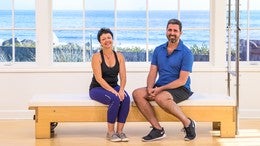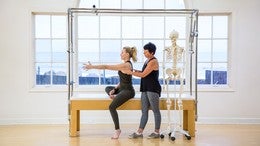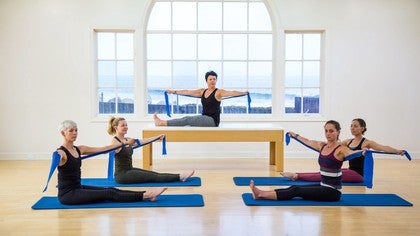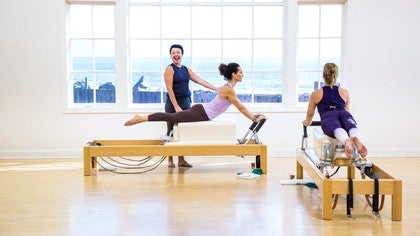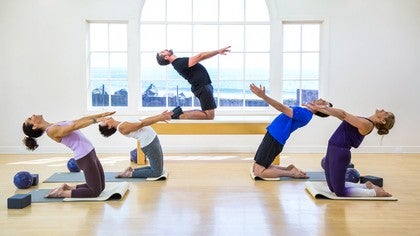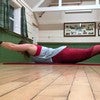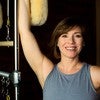Description
About This Video
Transcript
Read Full Transcript
Hi everybody. I'm Kara Reeser and I'm here to do a mat class. And this mat class is attached to the shoulder blade tutorial that Amy and I just filmed. Um, so you can take this class without the tutorial, but if you take the tutorial, it's going to help you sort of know why I'm obsessing on gps in your scapula. So that's sort of the theme. Okay. So a little bit what we're talking about is, you know, how do you know when you're trying to do your mat work and articulate your spine, how do you control whether or not you're doing too much of this kind of like arm, this scapular retraction or, or maybe even too much scapular retraction. How do we let that scapula sort of live on our rib cage peacefully as we actually manage our spines and our trunks, which is so much what, um, what we're learning during the mat work. So that's our focus and we're going to start right away with a, you need a theraband at home and a pair of tights and that's it.
Or sweat pants, shorts. All right, here we go. So let's step on this band to start. And I would say let's choke up so we can get some resistance. So you can imagine this band could also be the roll down Bar, right? It could be the straps on the reformer, right? It's force. It's resistance, right? So let's just feel right away, we're just going to do some scapular movements.
So we all know what our scapulas are capable of doing, right? So we're going to start with a little bit of elevation, straight elbows, and a little bit of depression, right? So we're going to let that band pull that scapula down. So we're going to go elevation, right? And depression. So this is one movement that the Scapula does often without our permission.
So one of the things we're learning in this class is how do we control our body parts from doing movements without our permission, right? We have to teach them just like we teach kids to do things without our permission, right? So here we go, up and down two more times. So this is elevation depression. One more breathing, good. And then without hurting yourself, step out of your band. And we're going to go to the movement of pulling and going into upward rotation. I'm going to turn around so people can see the scapula and then our scapula come together as our arms come down.
That's the downward rotation movement of the Scapula. So then they're going to go separate and lift, come all the way around, and then they're going to separate in lift and squeeze together and come back towards the spine three more times up. Yeah. So one thing I want you to think about at home is trying not to control your scaffold right now. Let it follow the movement of your arms, right? Let it really moved around your rib cage a lot. Yeah, so just let that happen. Right?
And now let's hold the band straight out and everybody at home, we're all going to be thinking about squeezing the whole entire medial border of the scapula together. That's Ab duction and then letting them come apart. That's ad duction or abduction. I said that wrong. A Di towards the spine. A B o away. Good.
Three more times and ask yourself, are you adding depression and an elevation? For some reason without its invitation. Are you adding something else? Are you adding some kind of spinal change without it's invitation to see if you can just focus on this one inward and outward motor movement. Great. And then leave the band to your, uh, arms down by your side and just roll down, allowing your spines to roll all the way down. Set the band. Oh No, we're gonna keep the band. Yeah.
Set the band to the side of your mat for a second. Squat on down and come to seed it. Okay, so before, before we use the band, we'll just leave it nearby. I'm going to turn this way just so you can see. But we're all going to bring our arms to this goalpost position and we're going to do seated shoulder shrugs, right? So without any force of the band, we're going to bring the tops of our shoulder bladers blades together, and then we're going to separate them, right?
But I'm trying to keep my arms in the same position. Medial borders of the scapula together. Separate them. Lower borders. Your elbows will come in a little bit. Separate them. Let's do that again. Apoe, upper borders together. Good. And then separate them, right. Middle borders together.
Right. And separate them. Lower borders of the scapula together. Inferior Angle, separate them. Right. Good. Let's just do that one more time. It's sort of interesting. See if we can get a little more moving this time. Squeeze and then really open those wings.
Middle Squeeze, open those wings. Lower corner, open those wings. Great. Bring your arms down by your side. Take your band to your feet. And now what we're going to be doing is we're going to have our knees bent. You're going to choke up on the band quite a bit, right?
And we're going to feel our scapula just resting on our back as it would be if we were standing with straight elbows. Now Roll on back and see if you can let your spine articulate without letting that band pull your shoulder blades forward. But keep your elbow straight if you guys can at home and in the room. Great. Let's just check out when we come up. So can you, so lift her head, neck and shoulders, and it start to come up and see if you can avoid having that scapula. Pull your shoulders forward.
But everybody in the room straighten your elbows. And that means Leah and Amy. There we go. We're just going to go back one more time, right? So that bending the elbow is a different control. Straighten your elbows Leia, all the way. I know, but even there it is. There it is. She's like they are straight. That's what they all say. And we're going to go here. Good.
Now bend the knees and take the legs up to the ceiling. Choke up on the band even more. And let's practice a little bit of that scapula together. Scapula apart, letting the band, um, be maybe lower the feet a little bit so you have more resistance. And I want you just to feel what it is in that supine position to do that again.
Scapula comes together, scapula pulls apart, scapula comes together. Good scapula pulls apart, right? So we're just gps in one more time. Good. Make sure you're not coupling that coming together with down. It's not pulling down. It's just elevator doors. One more time.
Yeah. Great. Now keeping the scapula in control on the chest wall. Float your head and come up into an upper abdominal curl. But don't let your scapula get pulled. Now stay up there. Lower the legs a little, and let's do that. Scaffold a moment. Movement again.
Shrugging it back and forward.
Exhale up. Great. Management of the Scapula here. So the question is, how much force do you really need to control that? Right? So down. Right. For some people, not too much. And up. Good. One more time everybody. I'm loving the way that looks. This time. You're gonna let your legs go all the way down.
Head Up. Right? Keeping your scapula on the back of your chest. Roll forward. I think that was good, right, Amy? Yeah, that was better. Yeah. And then roll it down, right? So all that while I'm thinking, how do I manage that as I roll down, right? So I'm not Uber rounding and rural la up.
Head Up. That's it. Good. Jia and roll down. Great. Good. And last time and the band is actually helping us with the roll up a little too. So it's like a little added favor. Favor, flavor.
Good. And just take a forward stretch for a second. Go ahead and let your band rest there for a second and this or bring it to the side of your mat and lie down. Knees bent. And we're going to go into a shoulder bridge and I want you guys to go up articulating your pelvis. I want you to bring your scapula closer to the spine as you go up in the bridge. So you're going up and your scap is actually coming together, right?
And then when you roll down your scaffold, we'll come a little bit apart, but you won't have to see this like super forward. Motion your shoulders. Nice. Good everybody. And again, bridging up. Great. Gorgeous. Everybody's neck looks really good. I think you're going to notice it home. This takes some of the pressure off your neck to roll down because what you want is your chest wall. The back of your ribcage is on your Scapula, not falling back into your cervical spine. The last one up.
Nice, great and down. Good. So from that position, we're just going to lift the arms, right? We're going to lift the head, neck and shoulders. We're going to come up slowly into a sit up. We're not going to pull that scapula forward.
I got your back ear. Welcome. Great. So let's take our table. So you're going to take your arms behind you. Let's have our palms facing away for right now. Right? So just like in the shoulder bridge, everybody start to articulate your pelvis and as your pelvis comes up, I want you to bring your shoulder blades all the way together on your spine, holding that table, extending the front of your hips, right a little bit more scapula and Meredith, that's it. Perfect. So it's really takes a lot of power back there and then come on down.
Good. So I'm going to suggest this is a position our scapula, even in something like Jackknife or rollover. So let's go up one more time and visualize this. So if I were going into a rollover or a Jack Knife, I would want or shorts mine. I would want my scapula back under my rib cage like this. So we're going to come back down. We're going to be really managing that, right?
I'm not letting this happen. That would be my scapula. And we're going to come back in, right? And now you're going to take your arms forward. We're going to go ahead, back down, arms down by your side, legs to table, legs up. And then let's do that in. Roll over. So you're going to go over and rollover. You're gonna pull that scapula towards each other.
Open flex, roll down. Keep drawing the scapula towards each other. Right? Super. And I hope what you feel at home and sit down, your shoulders aren't tipping forward, right? It's the management of that AAD duction of the Scapula. Open and roll down. Gorgeous.
Good, nice pace. Good. Let's reverse the directions of the legs. Open. Flex. Keep that scapula moving towards the spine. Close the legs. Articulate the spine, but don't let it harass your scapula. One more time. Open and flex.
Okay, so let's reach the arms towards the ankle without overplaying through this capitol. Let's start to walk all the way up that leg. This is such a hard moment to not do that, right? Yeah, but the truth be told. Good. That was excellent. Now stay up there. Everybody. Take their ankle. Pull the leg in by bending your elbows and stretch. Don't let your scapula release out. And again, pull and reach. Good. Now let's just walk on down, but keep that scapula neutral on the rib cage. Yeah, super. Yeah. Yeah, that's great. Good.
Single leg circles. We're going to crossover. Inhale, exhale out and around. Inhale. Exhale. Out and around in. Exhale out and around. Other way. Now you could also think here, what do you have to do in your upper back to not have your shoulders pulling around your back? Last one. Good. Ben and Ian, grab the knee. Lift your head. This is like the most quintessential moment where people pull through here. So pick your chest wall up into your rib cage and up you go.
Everybody needs help from their friends from time to time. All right, so stay in that position and let's hold our chest wall in our scapula and do leg lifts up and down. Right of goodly a good. Everybody down up now switch legs. Oh yeah, baby. I gotta roll my pelvis sender without falling back through my scapula.
It takes a whole lot of concentration. And then I'm going into the other hamstring stretch. Head down, circle the ankle and breathe right. I'm going to check in again. GPS, my scapula on my rib cage. What's going on there? Good breathing. Take the leg to 45 you know the drill. You're going up. You're trying not to pull through your arms too much.
Yeah, exactly. Nice Ben in straighten the elbows. Right? And you can do that with biceps, right? You don't have to pull through your chest. What? Yeah, this looks look it out. Good. They look you guys. This is great. Good. So now you're going to keep that leg and you're going to walk down.
You're going to rotate that pelvis. Yeah. Good, good, good, good, good, good, good, good, good. And bend that knee into your chest. Roll up to Oh sir. Single leg circles. Great. She reminded me. Here we go. Over and up and around, over, up and around. Good. Four in each direction. Good. Can you feel how one shoulder gets pulled a little bit more than the other? Right. So this means on each side you have to do something a little different, right?
Each side of that awareness you have to do something a little different cause the tug. Last one, good knee into your chest and lift your head and manage that gpss. Capital of neutral on the rib cage. Up you go. The stakes are high. You guys are on your right leg. Perfect. Good. That was great. Good. So one of the December times, it feels also like I need to kind of hold my chest wall up as well. So we'll try to think of that cue as we lower and lift that leg.
Good. Try not to go to the strategy of pulling your scapula down. Just let it be floating on the rib cage. Okay, so here we go. We all know what happens in the exercise called rolling like a ball, right? He said, we're going to control that. We're going to pick up our booties. Inhale, roll back. Exhale.
Inhale back. Exhale up. Good. Keeping control of the SCAPULA and not letting it get pulled by the ankles. Inhale. Exhale. Two more. Super. Yeah, so we're going to go back. You're going to come up. Take your right knee and shut your left leg out.
We've got that same descent here. We're going to do all the whole abs series, so we're going to be thinking, Huh? I'm not going to let these hands pull my scapula. I'm going to keep my head curl up. Inhale, one, two, exhale. Three, four. Inhale, one, two. Good.
Now keep rolling up into your shoulder girdle as opposed to polling your shoulder girdle forward and both knees in. Inhale, stretch it. That's your upward rotation. Exhale. Good. Inhale, exhale. Good up x. One more time. Up and x. Now here's that scissors. It's a hard moment. Go pull, pull, switch, pull, pull. Try to keep that organized. Keep it together.
One more set. We've got it now. Take your hands behind your head. Now in my world today, I'm going to ask us to scoop our scapula up and keep our elbows more narrow. That's going to assist this, this study that we're doing. Inhale, lower both legs. Exhale, recover. Inhale, exhale. Inhale, exhale, and elbow to knee out towards the ocean, and inhale.
Exhale. Now what are your scapula doing here? Could they follow the trunk instead of just like pull around so much? Nice. Everybody and knees in and rest. Good. Send your right leg.
I'll hold onto your left knee and roll up to seated. Super. Yeah. Good. Does that feel a little different? That, that looks great. Go ahead and take your therapy and we're going to do spine stretch seated forward. Well, let's just use the therapist here, pulling out just slightly again, we're going to move forward. Just slide your scapula forward and back for a second and then find that neutral position again, pull out on the band a little bit to give you a sense of that. Drop your head.
Start going into whatever version of spine stretch forward you prefer, but don't let your scapula lead. Yeah, and then bring your spine back up and then take the arms overhead and let's do that full range of motion of the scapula again, up and around, and inhale. Exhale over. It goes. You're thinking about not letting your scapula runaway on your back. You're rolling up. You're stacking the spine breathing. Then you're going full scapula together and Scapula.
Back to that neutral position. One more time. Pulling out. Dropping your head. Yeah, keeping. Yeah. This looks so nice. Just the awareness and stack back up and then take that bar up and over and let your scapula really rise up there, Leah. Yeah, gorgeous. And back around. Lovely. You guys and rest. Take that band.
Set it to the side again. Okay. I feel like openly rocker is one of like the hardest places to control that. So because my legs are so heavy, I need to to even think a little bit more control. Not Down, but just towards the spine. Am I gonna fall from that? No, I think I'm all right. I'm a little one. And inhale back. Exhale up. Oh, inhale back.
So figure out what the stakes are for you. Yeah. Leah lifters capital up a little, but control it towards your spine more. There you go. That's better. Yeah. Great. Good. Mary. Two more. Good. Everybody good? So I feel like that's more spine, right? One more time. Great.
Or more trunk I should say. Bring the legs together. Arms here. Yeah, let's be real fancy and just creep on down. Bend your knees to tabletop to tick talk. Now I love to think about this because as I go over to the right, I'm going to go all the way over until my thigh touches my hand. But I am not gonna let my left Scapula get pulled off that mat.
So I'm going to control it and back up and other side. Inhaling. So I have to do different things with different Scapula scapulae and with my Mike Pack. Keep going. Everybody inhale. Good and back around. That looks so great on that. Supporting arm and over. Yeah. Fantastic.
So as your legs change, you need a little more force, right? So you're modulating your calibrating how much? Four. She need one more to each side or is that your finishing side? One more to the next side. Who knows? Right and left anyway. Right? And back to center. Super Duper. Put your arm in.
Put your feet down. Good. And stretch your legs out. Reach your arms up and roll up to seated again. Don't pull through that scapular. Good. Take your theraband and we're going to bring your therapy and around your back right now, your upper back.
And we're going to hold it for spine twist seated. So as you twist, I want you to use that band to bring awareness to keeping your scapula pretty well wide. So we're going to go towards the ocean. We're going to twist one to center, one to center, right? So I can feel how I want to squeeze that one scaffold to midline to help my twist. But instead I'm going to keep both scapula neutral and I'm going to rotate through my trunk.
Hello Dolphin and rotate and one more to each side. Oh, and then I'm like, Gosh, I don't really twist that. Oh, surprise as you see what I'm saying. Right? So you take some of those compensations out and it's like, oh, all right, come onto all fours. Okay, so I like to call this exercise, lazy cat, active cat. You can call it whatever you want. We're in all fours. We're at a relatively a diagonal spine neutral ish, and you're going to collapse those two scapula together and then you're going to press your arms into the mat until they separate.
And you're going to do that again. You're not going to add flection or extension, you're just going to do this through your scap. That was better, Leah, and just your scapula closing. Just your scapulas separating just your scapula closing, just your scapulas separating. Now keep the push of the separation of the Scapula. Tuck your toes under and lift your knees off the mat and take three deep breaths and see what it takes to maintain equal distance.
Those two Scapula, while you're maintaining this right, more forces needed because gravity is screwing with you basically. Right? You got that and arrest. Good. Now take those arms a little bit forward. I call this camel drinking the water again. Let's go lazy cat, active cat, head up, bend the elbows, and I want you to tap the elbows down and straighten them. And I want you to keep that widened position of the scandal. And again, Vendrell was tap them down, right? And push you.
You have to really use more force that your scapula doesn't collapse here as you bend your elbows. This is a good preparation for pushup, Chaturanga all those sort of, you know? Yeah. Meredith, that looks great. Yeah, that's it. Good. Nice, beautiful. And so now bring your body weight back over your shoulders. Come out into a full plank and just sort of manage that position for a moment. We're going to bend our elbows, shift forward and come down. Good prone shoulder shrugs. Take your arms out to the goalpost position. Again, I learned this in a Forrest yoga class and I've just, I've, I've done it ever since. It was very enlightening for me.
So you're going to lift yourself up a little bit. Head, neck, shoulders. Now let's all try it again. Our arm. Sorry, how about that? I didn't say that. Wrists a little higher than your elbows. That's already impossible. And then let's squeeze the lower part of her scapula together. And separate. Squeeze. Squeeze, squeeze. Separate. Middle Boarder.
Squeeze. Separate. It's really hard to do while you're talking. Squeeze. Yeah. Separate. Good upper borders. Twice. Yeah. So just like a little gps, like the whole thing's gonna move, but it's nice to concentrate on what you're trying to do. Good. Now put your hands down first. Swan.
That's where your triceps come to the swan and up against we go operate. We don't pull our scapula together because our arms are actually moving in front of us, right? We have that full extension experience. And then watch it as you bend your elbows. Don't let this collapse. We're going to bend the elbows. We're going to control that. That's why I teach that camel.
Do you guys feel how that applies to more times up? Good. Great. So what have you got your elbows a little bit more narrow as you vent them event, right? That's it. Yeah, that looks so good. Good. And now let's go into single laid kicks. So bring our arms forward and come into that position. Right, and can I see that little bit of fallen row and separate here.
So here we are. Here we are. Here we are. Here we are. Let's all do that one more time. Here we are together. Here in now this push we're going to keep as we go.
Now we're going to clap the hands. Turn your head to the right triple kicks, kick, kick, kick. And now this is the position that we had in that tabletop legs, arms coming all the way together. Turn your head kick, kick, kick, all the way together. Bring those blades together and kick, kick, kick. And if that's too much for you, Amy's modifying with the hands apart. That is absolutely fine. Kick, kick, kick up. Nice. Why a one more full set that means one to the right and one to the left and kick, kick, kick and up. And rask. Good pullback into child's pose. And take a moment here. I always, when I do this particular practice of the shoulder blades, I always feel like I got like a great neck massage after, you know, I hope you guys will feel that way. Um, okay, we're going to swing our legs around.
We're into neck pull now and we know neck pull is a big culprit for this because the stakes are high on the trunk, right? So let's just do our best. Uh, it's, it's not many people's favorite, but that's okay. We just practice, right? So I could have my hands here, but I'm not going to have my scapula crushing together because that's going to make it difficult for me to articulate my spine. So I'm actually gonna pull my scaffold a little bit apart. Now that we've learned that, we're going to tip back and we're going to find that articulation going down without dropping through our scapula. Everybody, that's your arm variation. That's mine too. All the way back, right?
So you want to change your arms whenever you need to. I'm going to reach my arms forward here. I'm going to try to roll up very tight and low without pulling that scapula forward. Take a little stretch. Stack it up again. Wide Scapula here. Tip back. Articulate. Yeah. Super. I love this holding up your scapula. You too.
That it's not something I see in both you very often. So it looks great to me. Yeah. And then you're going to reach your arms forward or keep them how you are. Whatever you want to do. Hold that scapula up. Yeah. Super Nice Amy. That was better. Yeah. So sometimes we take away that compensation and we actually find something else.
Right. It's not always torture. Sometimes it's actually discovery as well. Yes. We're going back. We've got that articulation. Yep. And we're going to have, Yep, there's that too. And then there's that one more coming up. I'm going to attempt it with my hands here. Oh, I want to pull my scapula forward. Oh so bad. And Stack your spine, bend your knees, take yourself back down.
And we're going to do a shoulder bridge with the arms clasped because I think it's actually really useful to practice this way from time to time. So the heels closer to the sits, you're going to scoot your shoulder blades around. This is how the Yogis often practice, and then we're going to come up into that bridge, curling our tail, extending our hips. Now really, really stamp your arms down and stay up in that bridge for a couple of breasts. And I want you to notice how you have no weight on your neck and in your thoracic spine if your shoulder blades are together. Good. That's something I'm interested in and roll down. Yeah.
So in those cases, we're taking all of the load off of this area right by making this little tray for our rib cage and up again. So Mary, I would say you can go a little more sooner with your blades coming around. So you guys want to be willing, really activating your upper back, stamping your risks down into the surface of the mat, pushing with your hamstrings to stretch the front of your hip. Yeah, right. You're also smiling across your collarbones and your faces and her all down. Right? So that's where that comes from. And let your arms separate. Yeah. Reach your arms forward, roll up again.
So there's lots of rolling up and down in this class. Excellent. And then let's do a back plank. Now this should be more available to us since we've been doing this the whole class. But what we need for this is that full a d duction and then shifting into hip extension. So let's hold that for one.
Mostly just pro. Yeah, that's way better. Now keep squeezing the upper portion of your scapula together. That's a girl. Nice job. Good, nice, good. Keep pushing. Keep doing your scapula. Everybody on TV. Do Your Scapula or I'm on TV or in the audience, but go and down.
All right, super. Great. That's great. So bring yourself legs forward. Oh No, actually side laterals can't do it without it. Pull up your tights. You guys actually don't have to do that. You can face each other still. It's it's cause I can't straddle the Cadillac without looking kind of weird. Okay, so let's take your right hand behind your head, but let's make sure that capital is not crashing into the spine.
And let's go over to the right, right? And then I want you to keep your arms on the same plane. Rotate your trunk to your knee, come back to side position and come up. Switch arms. So we're going over. You're trying to keep your shoulder blades the same and rotate your trunk.
Do you rotate your trunk and back up? I'm going over to the side Nipples to the front wall, keeping my shoulder blades the same. I'm going nipples to my thigh.
Simply rotate gorgeous and back up and homeless. That Walmart in each sides even can go a little further in your range. Go over and shift. Rotate r d rotate and recover better and over. And it's like rotate and around
Bring yourself to your supine position for teaser. So it's too bad that that word panics everybody. But we should call it something else. But in this case, we're going to lift our heads. We're not going to pull through our shoulder blades. Look at your toes, lift your feet, float your trunk up. Take your arms here. I'm sorry.
Like this and shoulder shrugs together apart. So what does that do to your teaser? That's interesting, mom, and reach your arms out rolling down, right? So one of the things that happens on the machine and let's go up again, is that we do those arm circles and we all think it often throws us off. So this is a great place to play with. Hey, can I allow my scapula to do some free movement and not let it harass my teaser? Yes, super. Reach your arms forward, roll down. Love it. Last time you're just going to come up into that teaser.
Let me come back up to that teaser. I know. Yeah. And then let's just practice bringing those arms around the back yet, bringing those blades together. Ben, bring your arms around. Little bit of boomerang variation. One more time. Take it. Just see if you've got that woo and home. Bend your knees, grab your ankles. Now we know how easy it could be to slide through the scapula here. We're going to hold it neutral on the spine. Clap, clap, clap, roll back, clap, clap, clap, roll up, clap, clap, clap, roll back. Roll Up.
Good. They look like seals, baby seals. All right, one more set. Now you're gonna roll up to standing after this already squat to stand. If you've got it, bring it home. They all have it. Great. So let your arms come down by your side for a second. Close your eyes, everybody on screen and off.
And just feel, just concentrate on the sensations of your upper body for a second, right? And just notice that the alignment that sort of came forward here and just drop your heads. Ah, and roll that spine down. I love rolling down from standing and let yourself just rag all over. [inaudible] I've dropped my mic pack like six times to en or roll back.
So excellent work, ladies. Thanks for coming. You're welcome. Yeah. Good. Thanks everybody for watching.
The Teacher's Corner - Playlist 12: Neck and Shoulder Awareness
Comments
You need to be a subscriber to post a comment.
Please Log In or Create an Account to start your free trial.
